Презентация What is a single party state

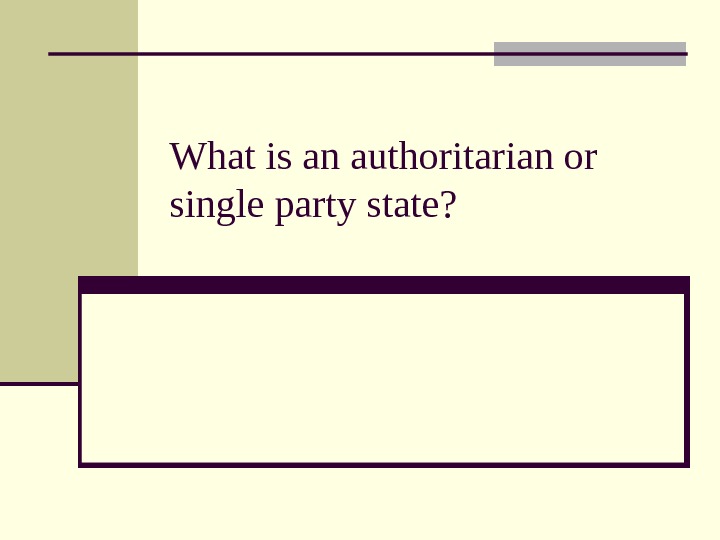
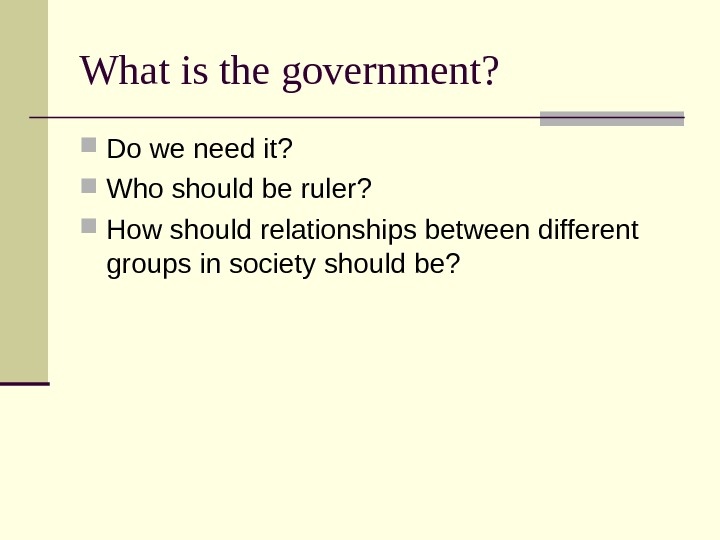


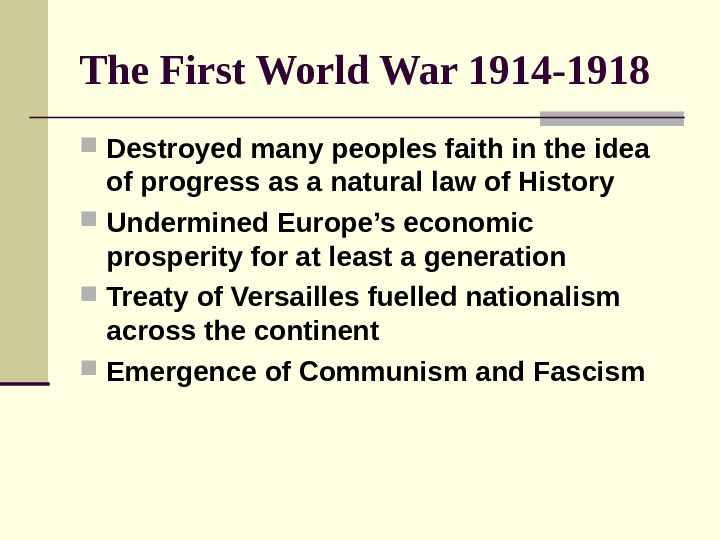
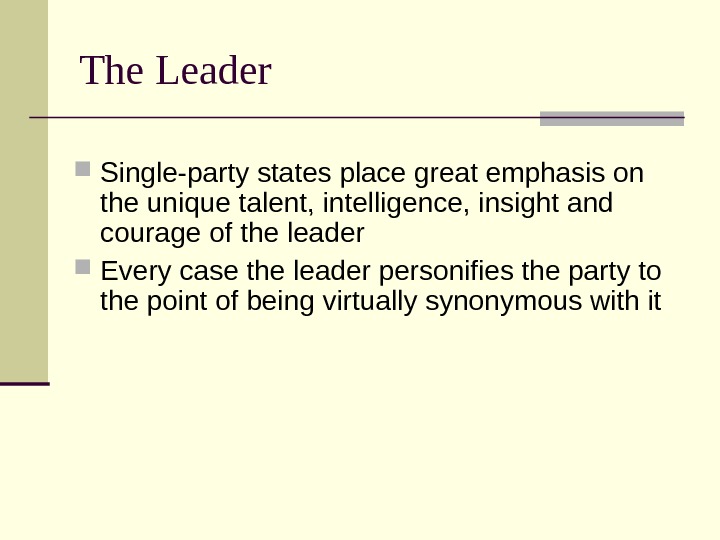
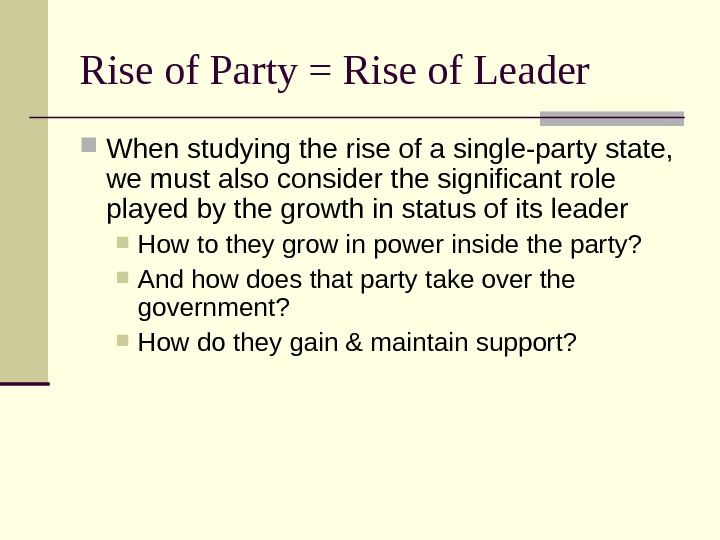

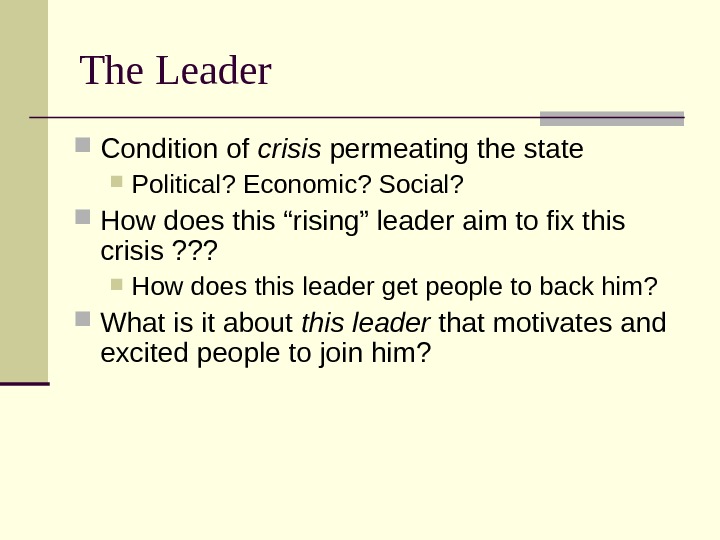
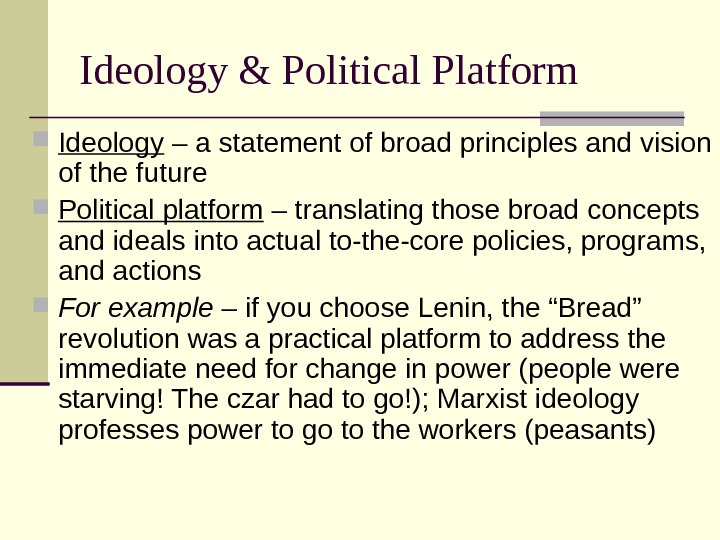


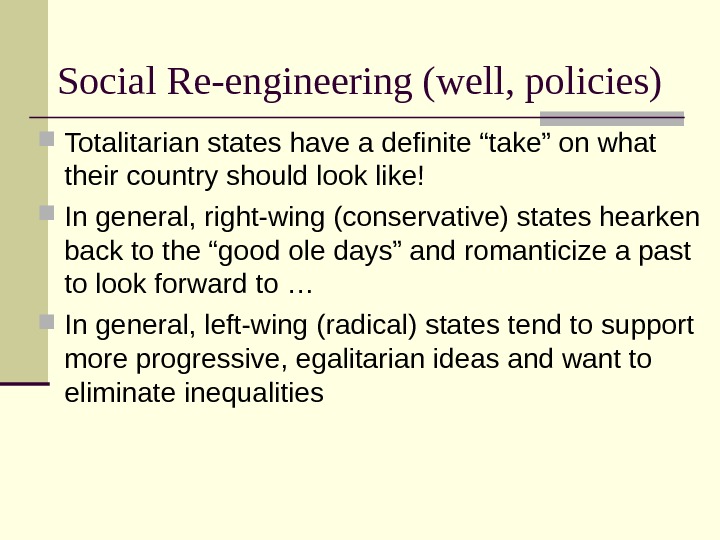
- Размер: 223 Кб
- Количество слайдов: 13
Описание презентации Презентация What is a single party state по слайдам
 What is an authoritarian or single party state?
What is an authoritarian or single party state?
 What is the government? Do we need it? Who should be ruler? How should relationships between different groups in society should be?
What is the government? Do we need it? Who should be ruler? How should relationships between different groups in society should be?
 Characteristics States restrict individual liberties to ensure the well being/rule in the interest of the state A state (country) with one powerful leader An official ideology imposed by the state, with no alternative viewpoints. An official plan that covers a large aspects of life (public and personal) A single mass party that represents a small percentage of the entire population. Usually very committed to the party and the implementation of the plan
Characteristics States restrict individual liberties to ensure the well being/rule in the interest of the state A state (country) with one powerful leader An official ideology imposed by the state, with no alternative viewpoints. An official plan that covers a large aspects of life (public and personal) A single mass party that represents a small percentage of the entire population. Usually very committed to the party and the implementation of the plan
 Characteristics A government monopoly (total control) of the media and culture, used for propaganda. This also includes religious institutions and schools Government monopoly of the police and military Use of secret police and a vast repressive machinery Government control of all key institutions, such as the army, youth movements and workers organizations No independent rule of law (Government controls judges!) Government control of the economy
Characteristics A government monopoly (total control) of the media and culture, used for propaganda. This also includes religious institutions and schools Government monopoly of the police and military Use of secret police and a vast repressive machinery Government control of all key institutions, such as the army, youth movements and workers organizations No independent rule of law (Government controls judges!) Government control of the economy
 The First World War 1914 -1918 Destroyed many peoples faith in the idea of progress as a natural law of History Undermined Europe’s economic prosperity for at least a generation Treaty of Versailles fuelled nationalism across the continent Emergence of Communism and Fascism
The First World War 1914 -1918 Destroyed many peoples faith in the idea of progress as a natural law of History Undermined Europe’s economic prosperity for at least a generation Treaty of Versailles fuelled nationalism across the continent Emergence of Communism and Fascism
 The Leader Single-party states place great emphasis on the unique talent, intelligence, insight and courage of the leader Every case the leader personifies the party to the point of being virtually synonymous with it
The Leader Single-party states place great emphasis on the unique talent, intelligence, insight and courage of the leader Every case the leader personifies the party to the point of being virtually synonymous with it
 Rise of Party = Rise of Leader When studying the rise of a single-party state, we must also consider the significant role played by the growth in status of its leader How to they grow in power inside the party? And how does that party take over the government? How do they gain & maintain support?
Rise of Party = Rise of Leader When studying the rise of a single-party state, we must also consider the significant role played by the growth in status of its leader How to they grow in power inside the party? And how does that party take over the government? How do they gain & maintain support?
 Discussion Point: Creating the “myth” All totalitarian leaders in the 20 th C have been men. Many of the stereotypical qualities of leadership summed up in the phrase “a man of action, ”including courage, determination, commanding physical size and strength, are strongly identified as masculine attributes. Also, all societies in which totalitarian leaders have come to power were more “traditional” Would it be possible to have a female totalitarian leader?
Discussion Point: Creating the “myth” All totalitarian leaders in the 20 th C have been men. Many of the stereotypical qualities of leadership summed up in the phrase “a man of action, ”including courage, determination, commanding physical size and strength, are strongly identified as masculine attributes. Also, all societies in which totalitarian leaders have come to power were more “traditional” Would it be possible to have a female totalitarian leader?
 The Leader Condition of crisis permeating the state Political? Economic? Social? How does this “rising” leader aim to fix this crisis ? ? ? How does this leader get people to back him? What is it about this leader that motivates and excited people to join him?
The Leader Condition of crisis permeating the state Political? Economic? Social? How does this “rising” leader aim to fix this crisis ? ? ? How does this leader get people to back him? What is it about this leader that motivates and excited people to join him?
 Ideology & Political Platform Ideology – a statement of broad principles and vision of the future Political platform – translating those broad concepts and ideals into actual to-the-core policies, programs, and actions For example – if you choose Lenin, the “Bread” revolution was a practical platform to address the immediate need for change in power (people were starving! The czar had to go!); Marxist ideology professes power to go to the workers (peasants)
Ideology & Political Platform Ideology – a statement of broad principles and vision of the future Political platform – translating those broad concepts and ideals into actual to-the-core policies, programs, and actions For example – if you choose Lenin, the “Bread” revolution was a practical platform to address the immediate need for change in power (people were starving! The czar had to go!); Marxist ideology professes power to go to the workers (peasants)
 Delivering the Message & Taking Power Methods used to “get the message out” Propaganda !!! Slogans !!! Posters !!! Also Education, Arts, Rallies Taking power Democratically (Hitler & Mussolini), but still used moderate violence and confrontation By force (Castro, Mao, Lenin), with guerrilla warfare and military coup d’etat
Delivering the Message & Taking Power Methods used to “get the message out” Propaganda !!! Slogans !!! Posters !!! Also Education, Arts, Rallies Taking power Democratically (Hitler & Mussolini), but still used moderate violence and confrontation By force (Castro, Mao, Lenin), with guerrilla warfare and military coup d’etat
 The Elimination of the Opposition The mistakes or shortcomings of opponents are crucial to the success of the new leader and the party in their attempt to seize and hold onto power Address regime change & how the defeated party failed to respond effectively to the crisis A power vacuum in created through which the new leader and his party rise to take control Be sure to use good examples here! Tell the story, have it come alive for us!
The Elimination of the Opposition The mistakes or shortcomings of opponents are crucial to the success of the new leader and the party in their attempt to seize and hold onto power Address regime change & how the defeated party failed to respond effectively to the crisis A power vacuum in created through which the new leader and his party rise to take control Be sure to use good examples here! Tell the story, have it come alive for us!
 Social Re-engineering (well, policies) Totalitarian states have a definite “take” on what their country should look like! In general, right-wing (conservative) states hearken back to the “good ole days” and romanticize a past to look forward to … In general, left-wing (radical) states tend to support more progressive, egalitarian ideas and want to eliminate inequalities
Social Re-engineering (well, policies) Totalitarian states have a definite “take” on what their country should look like! In general, right-wing (conservative) states hearken back to the “good ole days” and romanticize a past to look forward to … In general, left-wing (radical) states tend to support more progressive, egalitarian ideas and want to eliminate inequalities

